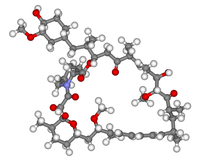
Photo from wikipedia
The target of rapamycin (TOR) pathway is an evolutionarily conserved signal transduction system that governs a plethora of eukaryotic biological processes, but its role in Cryptococcus neoformans remains elusive. In… Click to show full abstract
The target of rapamycin (TOR) pathway is an evolutionarily conserved signal transduction system that governs a plethora of eukaryotic biological processes, but its role in Cryptococcus neoformans remains elusive. In this study, we investigated the TOR pathway by functionally characterizing two Tor-like kinases, Tor1 and Tlk1, in C. neoformans. We successfully deleted TLK1, but not TOR1. TLK1 deletion did not result in any evident in vitro phenotypes, suggesting that Tlk1 is dispensable for the growth of C. neoformans. We demonstrated that Tor1, but not Tlk1, is essential and the target of rapamycin by constructing and analyzing conditionally regulated strains and sporulation analysis of heterozygous mutants in the diploid strain background. To further analyze the Tor1 function, we constructed constitutive TOR1 overexpression strains. Tor1 negatively regulated thermotolerance and the DNA damage response, which are two important virulence factors of C. neoformans. TOR1 overexpression reduced Mpk1 phosphorylation, which is required for cell wall integrity and thermoresistance, and Rad53 phosphorylation, which governs the DNA damage response pathway. Tor1 is localized to the cytoplasm, but enriched in the vacuole membrane. Phosphoproteomics and transcriptomics revealed that Tor1 regulates a variety of biological processes, including metabolic processes, cytoskeleton organization, ribosome biogenesis, and stress response. TOR inhibition by rapamycin caused actin depolarization in a Tor1-dependent manner. Finally, screening rapamycin-sensitive and -resistant kinase and transcription factor mutants revealed that the TOR pathway may crosstalk with a number of stress signaling pathways. In conclusion, our study demonstrates that a single Tor1 kinase plays pleiotropic roles in C. neoformans.
Journal Title: Genetics
Year Published: 2019
Link to full text (if available)
Share on Social Media: Sign Up to like & get
recommendations!